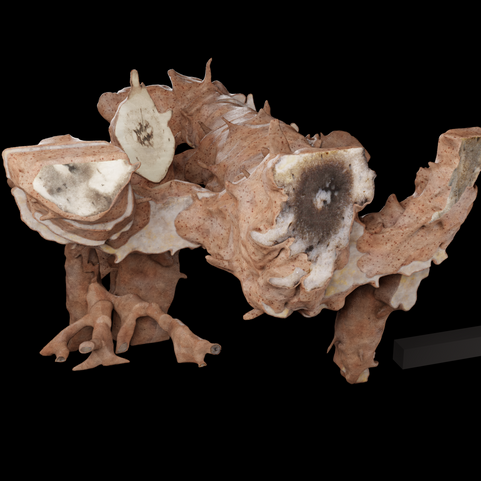
COMMISSIONS
Bring your science to life with still images, video, and 3D models. You provide the data, and I'll show you what's possible.
The only limit is your imagination.
THE STUDIO IS: OPEN
I am currently available for commissions. Take your research to a new dimension through 3D reconstruction, video,
or interactive models. If you want to discuss what's possible please contact me.
For technical and research support, or training possibilities please see here.

ASTEROXYLON MACKIEI: A VISUAL CASE STUDY
In a series of commissions with the Institute of Molecular Plant Sciences at Edinburgh University, I have produced multiple reconstructions of Asteroxylon mackiei, one of the earliest known Devonian land plants.
Phase One reconstructions provided the first well evidenced reconstruction of the structure and development of the rooting system of A. mackiei. The reconstructions were used in figures in the paper: An evidence-based 3D reconstruction of Asteroxylon mackiei, the most complex plant preserved from the Rhynie Chert by Hetherington et al., published in eLife, and the life reconstruction was used to head the press release.
Phase Two reconstructions formed an integral part of analysing the phyllotaxis of the plant, and the discovery of rare non-fibonacci spirals in this ancient specimen, overturning the assumption that Fibonacci spirals were ancient in all plants. The studio was a co-author in the findings published in: Leaves and sporangia developed in rare non-fibonacci spirals in early leafy plants by Hetherington et al., published in Science. The life reconstructions were used to head the press release, and an explainer video highlighting the research was produced.
Phase One:
Anatomical reconstruction
Thick sections were provided as digital cut-outs in blender by the research team. The geometry was normalised, and the gaps bridged. Using images of the specimen, the bridging geometry was sculpted into a complete reconstruction of the fossil. A suite of bespoke textures was created in Substance Designer that matched the exposed areas of the physical fossil, and wrapped over the model. The original photographs of the thick sections were then projected onto the exposed ends of the model. The camera positioning of the original figure images was matched and images rendered.
Life reconstruction
The conclusions of the paper were used in conjunction with existing literature to generate a photorealistic model of how the living plant would have looked in its native habitat. A suite of bespoke plant and soil textures were created in Substance Designer. Particular care was taken to depict the key features of the plant, the profile of the soil it grew in, and its interaction with that soil and base layer of the environment. The result is a visually engaging representation of Asteroxylon mackiei, and the first well-evidenced reconstruction of the structure and development of the rooting system of the most complex plant in the Rhynie chert.
Phase Two:
Anatomical reconstruction
Fossil thin sections were converted into manifold geometry, producing a series of convex hulls for the leaves and stems of two specimens. The individual elements wre joined together to create 3D models of the extinct specimens. One models was further processed, creating a digital transverse section through the apex of it's stem, allowing researchers to quantify the phyllotaxis of the plant. A new suite of bespoke textures were sculpted using Phase One's surface preparations, producing the first accurate cell based photorealistic textures for the plant.
Life reconstruction
Building on the anatomical reconstruction, mulitple photorealistic models of the living plant were created. One as an interactive model, allowing you to examine the stem of the plant yourself, and the second placing the specimen in its native habitat, using water droplets to contextualise scale.
Software used
Blender 2.92, Substance Designer, Photoshop









